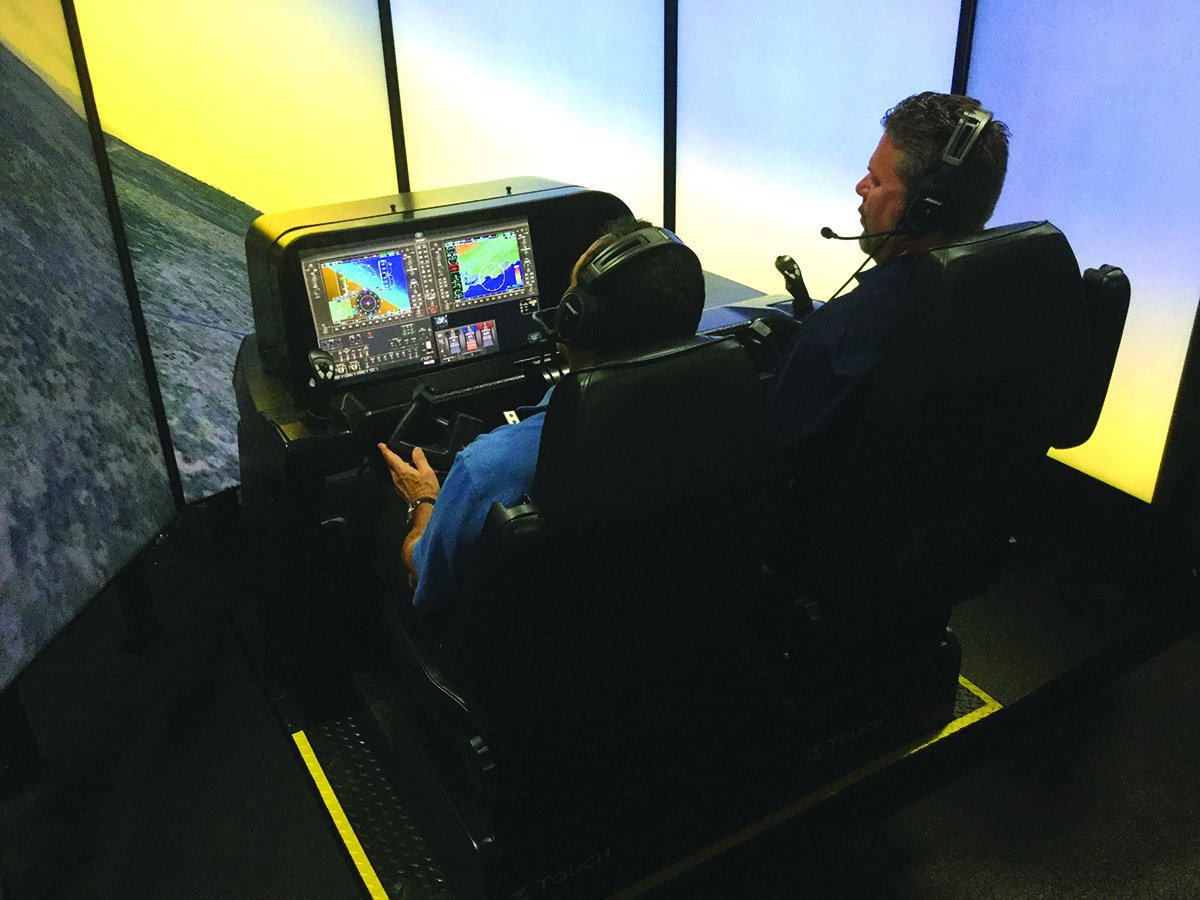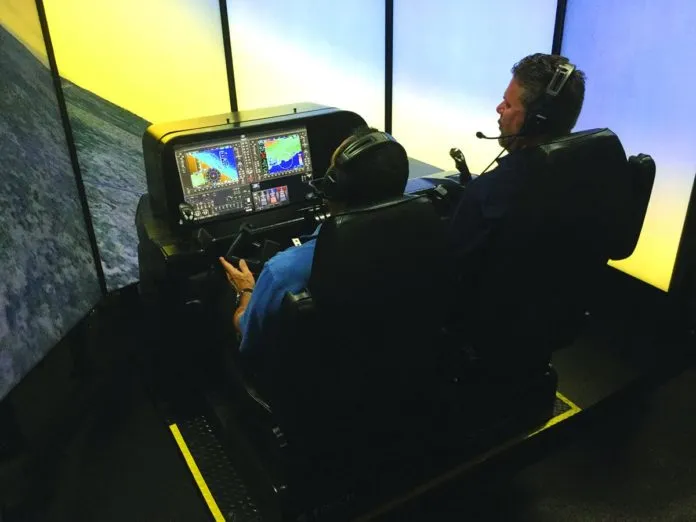We’ve clearly stated in a previous article that an instructor signoff is not required if you’re using a simulator (ATD) to maintain your instrument currency per 14 CFR 61.57(c) (3). So has the FAA. Then, in another article, we’ve just as clearly stated that an instructor signoff is, indeed, required. And, so has the FAA. Perhaps this controversy is something we should explore.
Under the Hood
Controversy is always a ripe subject for IFR, so we dug into this from different angles. We looked inside the FAA and found a can of worms. We researched the applicable Aviation Circular, AC-61.136A. We spoke to a couple different ATD manufacturers. We examined the simulators’ Letters of Authorization that formally specify what can be done in an Aviation Training Device or ATD, which can be either Basic (BATD) or Advanced (AATD). We researched the Federal Register as well as letters from the FAA’s Office of Chief Counsel.
FAA’s AFS-800 group regulates ATDs through Letters of Authorization (LOA) that specify the currency and training regulations that can be met in an ATD. If a device can legally be used to meet any FAA requirement, it has an LOA that specifies the details. These LOAs are typically issued per make and model of ATD. For example, a Redbird FMX at one location usually has the same LOA as any other Redbird FMX. But the Redbird MX2 will have a different LOA as will anything from manufacturer FlyThisSim.
For over 30 years, LOAs were issued inconsistently, causing confusion and controversy. For a time, AFS-800 even told operators incorrectly that LOAs supersede the regulations. They do not.
AFS-800 also regulates via Aviation Circular 61.136. Like the AIM, ACs are nonregulatory so they can be changed at will. Still, they have the effect of law in court. Inconsistencies within the AC have caused as much consternation as the inconsistent LOAs, especially for ATD manufacturers.
A New Day
On January 2, 2014, the FAA published an important policy statement in the Federal Register affecting Parts 61 and 141. Not new regulations, these were new policies discussing how those regs would be administered.
The FAA dipped into some background as to how LOAs can become stale with time due to evolving regulations and the uneven application of AC guidance. They offered one example that devices approved before July 2008 had not been approved under AC 61-136. As if to underscore their point, just 10 months later, they issued updated AC 61-136A.
Given the mess of LOAs, most issued without an expiration date, the FAA decided to reissue new LOAs to all current LOA holders, meaning manufacturers and owners. They cast a wide net including ground trainers, PCATDs, FTD levels 1-3, and ATDs currently holding an LOA. By January 1, 2015, all FAA-approved training devices had new LOAs except for those issued after August 23, 2013, which were deemed current and have expiration dates.

FlyThisSim
The Disconnect History
This backstory on the Letters of Authorization is an important element in the confusion. The reasoning is that the FAA devoted extraordinary effort to fix these LOAs so that they could be viewed properly in context with the regulations. Nonetheless, many arguments persist that the LOAs are stand-alone and need not be viewed with an eye on the regulations. For example, if an LOA says that the device can be used to satisfy IFR currency requirements, that was thought to be absolute and users need not read anything more into it—if the LOA didn’t mention the requirement for an instructor sign-off, none was required. We’ve concluded that’s an incorrect interpretation.
In April, 2009 the FAA published in the Federal Register a rule allowing the use of an aircraft, flight simulator, flight training device, aviation training device, or combinations for maintaining instrument currency. These became 61.57(c)(1-5); see 61.57 (c)(3) on the next page.
Within the preamble—the explanation provided with the regulation—the FAA argued that an instructor would not be required when maintaining currency using any of the methods as long as the pilot is current or within the second six calendar-month period.
Good—it’s settled. No sim instructor is required for instrument currency.
Uh, not quite. That same Federal Register had an update to 61.51—the regulation that describes the “acceptable manner” for documenting “aeronautical experience required for meeting the recent flight experience requirements of this part.” (61.51(a)(2)) The update revised 61.51(g)(4) for logging instrument time. See the text to the left.
So this regulation clearly says an instructor signoff is required when using a sim for instrument currency.
It didn’t take long for this conflict to reach the desk of an FAA lawyer. In August, 2010, Terrence Keller asked: “…whether the language of 14 CFR 61.51(g)(4), or the text of the preamble to rulemaking published in the Federal Register controls when an instructor must observe an individual using a flight training device or flight simulator to maintain currency.” (Keller, 2010)
The FAA lawyer responded clearly: “when the rule and the preamble conflict, the rule controls.” He continued, it “is clear that in order to log the time an instructor must be present.” The whole point of maintaining currency is to log proof of compliance.
Another fly landed in the ointment three months later in November, 2010, when an FAA official associated with ATD authorization made the argument that an instructor was not required because of the “training session” verbiage at the end of 61.51(g)(4). He argued that since maintaining currency didn’t involve a “training session,” an instructor is not required.
That’s a stretch. Training records are used in FAA-approved training programs, i.e. 141/142. Plus, the original 2009 Federal Register describes how that change was added at the behest of Flight Safety International, who noted that flight schools and training centers often track training in records other than a logbook.
Nonetheless, this prompted another FAA legal interpretation. This time, Andrzej Stewart asked “whether a flight instructor is required to be present when a pilot is maintaining currency in a flight simulator, flight training device or aviation training device.”
The lawyer responded: “Title 14 Code of Federal Regulations 61.51(g)(4) allows a person to use time in a flight simulator, flight training device or aviation training device for acquiring…instrument recency experience, ‘provided an authorized instructor is present to observe the time and sign the person’s logbook…'” (Stewart, 2014)
The lawyer then chastised Stewart for asking a question already answered in 2010 and included a copy of the Keller letter.
The Aftermath
That’s where we are today. Part 61.51(g)(4) is clear—an instructor (CFII) sign-off is required. FAA Legal resolved the discrepancy from 2010 between the Federal Register’s preamble to 61.57 and the change to 61.51. Then after an FAA employee reinterpreted 61.51 with some creative logic (Don’t blame the guy; he was trying to help us.), Legal re-issued its interpretation that an instructor sign-off is needed.
It’s true that 61.57 only says a person must “perform and log” time in an ATD and makes no reference to the further logging requirements of 61.51. Likewise, ATD LOAs say you can meet 61.57 without mentioning 61.51. But the omission of a reference to one regulation from another is not justification to ignore the first.
Some claim that since you do not need anything other than your own logbook entry (without an instructor) when you maintain currency in an airplane, using an ATD should be the same. That logic is compelling, but nothing in the regulations says that they can be ignored if they’re not logical or consistent.
Of course, nobody is looking over your shoulder, checking your logbook. The only time your currency would be questioned is if something else happened to draw an inspector’s attention. So, if your skills are current but you can’t legally prove it, chances are low that you’ll be caught.
That said, instrument pilots are best served by a conservative view of flying. Stay clearly and inarguably between the lines and you’ve got nothing to worry about. While the chances of getting busted for not having an instructor sign-off are small, they’re zero if you have one.





